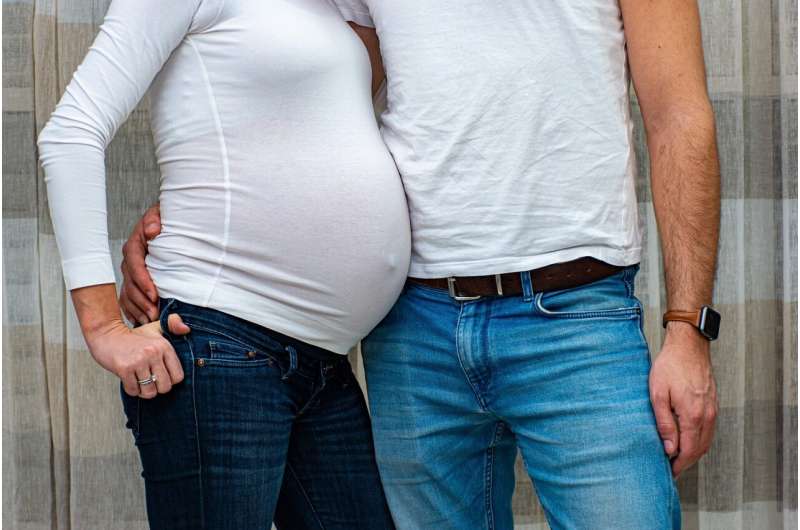This article has been reviewed according to Science X's editorial process and policies. Editors have highlighted the following attributes while ensuring the content's credibility:
fact-checked
peer-reviewed publication
trusted source
proofread
Maternal mortality in the US more than doubled between 1999 and 2019, study finds

A new study by investigators from the Institute for Health Metrics and Evaluation (IHME) at the University of Washington and Mass General Brigham found that maternal mortality rates have worsened from 1999 to 2019, hitting some racial and ethnic groups and states harder than others. Their results are published in JAMA.
"Maternal mortality is a crisis in the United States. These rates have been increasing over the past several decades and were exacerbated by the pandemic," said co-first author Allison Bryant, MD, MPH, senior medical director for health equity at Mass General Brigham. "Our study sheds light on the wide disparities within maternal mortality rates—the specter of maternal death differentially burdens some ethnic and racial populations."
Maternal mortality, or maternal death, is a death during or up to one year after the end of pregnancy. According to the Centers for Disease Control and Prevention, common causes of maternal death include mental health conditions—including death by suicide, and overdose related to substance use disorder—excessive bleeding (hemorrhage), cardiac and coronary conditions, infection, thromboembolism (blood clot), cardiomyopathy (a disease of the heart muscle) and hypertensive disorders of pregnancy (relating to high blood pressure).
Previous research has found that rates of different causes of maternal mortality vary by race and ethnicity. Bryant and co-authors used the National Vital Statistics System data on deaths and live births in each state and racial/ethnic group between 1999 and 2019. They then used a modeling process to create estimates of maternal deaths over those periods. This modeling estimated maternal mortality for each state and each race and ethnicity out of every 100,000 live births without potentially breaching any person's privacy.
"These disparities in maternal mortality are just the tip of the iceberg and tell us a lot about the health risks facing people in the states where these deaths are most likely to occur," said Greg Roth, associate professor in the Division of Cardiology and Director of the Program in Cardiovascular Health Metrics at IHME.
"In the U.S., maternal deaths are often caused by vascular diseases like severe high blood pressure or blood clots. So maternal deaths share many of the same drivers as heart attacks, strokes, and heart failure. Our state-by-state research emphasizes where we need to focus our prevention efforts and which groups are suffering the most."
For all ethnic and racial groups, maternal mortality more than doubled over this time period. These rates have been rising most substantially for American Indian and Alaskan Native people. The maternal mortality rates for Black women were the highest of any group, but the average of state-level rates had started to plateau around 2015 (pre-COVID) for Black women. Factors like structural racism and interpersonal racism play into these disparities, Bryant said. Substantial prevention and awareness efforts around maternal mortality may have had an impact for some populations, but not all.
Maternal mortality rates and disparities varied widely across states. The South had high maternal mortality across all race and ethnicity groups, but especially for Black individuals. Black individuals had the highest maternal mortality rates in some states in the Northeast, which tripled over the time of the study. Maternal mortality rates in the Midwest and the Great Plains states were where highest rates were found for American Indian and Alaskan Native women.
"Often, states in the South are called out as having the worst maternal mortality rates in the nation, whereas California and Massachusetts have the best. But that doesn't tell the whole story," Bryant said. "It's essential to look at the disparities between populations that exist even in the 'best' states."
The study had several limitations. The researchers didn't always have access to information about the causes of maternal death. And the way maternal deaths are recorded on death certificates has changed in the U.S. over the time of this study.
The data used in the study stopped prior to the pandemic in 2019. National data show maternal mortality increased in 2020 and 2021 when it was harder to access health care. The pandemic also hindered some prevention efforts to decrease the deaths of Black women. The pandemic may have widened the disparities seen in this study, Bryant said.
"Our findings provide important insights on maternal mortality rates leading up to the pandemic, and it's likely that we'll see a continued increase in the risk of maternal mortality across all populations if we analyze data from subsequent years," Bryant said. "Black individuals would likely still have the highest rate, but there may be a higher uptick in some of the other groups in the last few years. As we emerge from the pandemic, we must renew our focus on addressing maternal mortality."
More information: Fleszar LG et al, Trends in state-level maternal mortality by race/ethnicity group in the United States, 1999-2019, JAMA (2023). DOI: 10.1001/jama.2023.9043




















